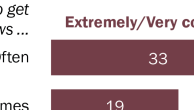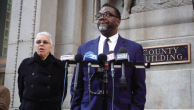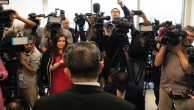Media Collaborations at the Statehouse
With fewer resources, legacy organizations have had to figure out new and creative ways to cover news out of the statehouse. A number of them have adopted an approach that in the past would have been unusual, if not unheard of—collaborating with the competition. Other outlets are combining resources with sister papers, broadcasters or digital-only outlets.
Perhaps the most notable example of collaboration has taken place in Florida. The Miami Herald and the Tampa Bay Times (formerly the St. Petersburg Times) used to compete to break stories in the Tallahassee statehouse. Faced with layoffs in late 2008, the papers merged their bureaus. Now, like other former competitors in state capitols across the country, these two one-time rivals share stories, blogs, assignments and resources.
The two papers each staff the capitol bureau with three reporters, who divvy up beats and daily assignments so as not to overlap. Every story and blog post the reporters produce can be used by both papers, whose editors decide what to run, said Mary Ellen Klas, the Herald’s Tallahassee bureau chief. While the combined bureau still competes for scoops with other Florida news outlets, Klas said the reporters from the Herald and the Times don’t feel the heat the way they did when they were rivals. “I think the absence of competition affects what our editors demand of us,” she said. “Stories that in the past they would want us to be all over, it’s a little bit harder for us to make that sell now.”
In another unusual arrangement, the eight largest papers in Ohio share state government and other stories through the new Ohio News Organization. The arrangement began in 2008, when the top editors met to try to figure out how to get around what they considered high fees charged by the Associated Press.
Other regional competitors have made similar arrangements. In North Carolina, the Charlotte Observer uses stories written by reporters from the (Raleigh) News & Observer. In Maine, the Bangor Daily News and the Lewiston Sun Journal share stories. Four news organizations on different platforms share content. In Missouri, for instance, the St. Louis Beacon, a digital nonprofit, has merged its newsroom with that of KWMU-FM, a National Public Radio affiliate.
There are other sharing arrangements, too.
Pew Research identified 12 papers that syndicate coverage on behalf of a larger parent company. In Illinois, for example, the State Journal-Register covers the statehouse for all newspapers owned by GateHouse Media. Four newspaper chains—Lee Enterprises, Gannett, Media General and Community Newspaper Holdings Inc.—have statehouse bureaus in which reporters produce stories for all the papers in the chain. This saves money because they don’t need to have individual bureaus with separate staffs. And more than 20 small-circulation papers share reporters with one or more sister publications owned by the same company.
Some outlets are engaged in more than one type of collaboration. In Vermont, the Times Argus and the Rutland Herald, which are owned by the same local family, share two reporters who cover the statehouse year round. Steven Pappas, editor of the Times Argus, said his paper also links to coverage by Vermont Public Radio. Moreover, he said, the paper’s website carries gavel-to-gavel legislative coverage provided by Orca Media, a local, nonprofit production facility that provides programming to central Vermont.
“We try not to duplicate efforts so we can give readers a more scattershot view of what’s going on in the statehouse,” Pappas said. “As the editor of this daily newspaper, it’s critical for me to have state government stories on the front page every day, as well as stories from my core cities.”
Newsmakers Becoming News Producers
Another consequence of the reduction in statehouse reporters is a growing stream of legislative information that is going to the public directly and circumventing media scrutiny and vetting, according to numerous reporters and press secretaries.
The internet, as well as other new media technology, has made it easy for public officials to go straight to the people. While that makes government information more available to those who seek it out, it also reduces the news media’s historic role as watchdogs. And a Pew Research report released last year included a public endorsement of that watchdog role, with 68% of respondents saying that press criticism of political leaders keeps them from doing things that should not be done. That represented a jump of 10 percentage points from two years earlier.
“We have to rely more on getting out press releases, and we’ve expanded some of our coverage on Capitol Television, our cable TV network,” said Larry Berman, communications director for Rhode Island House Speaker Nicholas Mattiello, a Democrat. “We post online all of our hearings and press conferences. If reporters want to write about it, they watch online.”
In Pennsylvania, lawmakers try to make up for the dearth of television reporters by offering to do interviews remotely—and by providing their own news feeds, said Stephen Miskin, spokesman for the House Republican Caucus and for the speaker and majority leader. Television stations can pick up videos of individual legislators from the caucus’s website, he said. While that process allows lawmakers to speak to the public without a filter, Miskin said the audience is smaller than it was when the press corps was more vibrant.
“We have to rely more on getting out press releases, and we’ve expanded some of our coverage on…our cable TV network,” said Larry Berman, communications director for the Rhode Island House Speaker. “We post online all of our hearings and press conferences.”
In Illinois, the House and Senate provide live audio and video streams of floor sessions and committee hearings, said Steve Brown, press secretary to Speaker of the House Michael J. Madigan, a Democrat. “In some ways, you may be able to get more information because there are more things available to average citizens through state government itself,” said Brown, who has worked in the capitol for more than 30 years, initially as a newspaper reporter. But, he added, “It’s not the same as when your news was dropped at your door.”
Gene Rose, a communications consultant who specializes in state government, said that when he worked for the National Conference of State Legislatures, an annual convention for public information officers focused on media relations. Starting in about 2005, he said, the group “turned to putting together your own newsrooms because we saw the departure of legacy media.”
The government-provided feeds have another, unintended effect: They have made it easier for journalists to cover state government remotely, without actually going to the capitol.
“I’ve watched a number of hearings on TV,” said Jim Panyard, communications manager for the conservative watchdog Media Trackers Pennsylvania. “Thank God for the Pennsylvania Cable Network.”
While these direct ways of communicating with the public may help compensate for some reporting gaps, some statehouse reporters and press secretaries alike expressed concern that the increased availability of information through state websites and cable channels has not led to greater public awareness of government actions.
[and]
Furthermore, several reporters said, information distributed by state officials may be one-sided and lacking context.
“I think in a way because of the internet, there’s more information being put out, but the information a lot of times is partisan,” said Bobby Harrison, capitol bureau chief for the Northeast Mississippi Daily Journal. “As far as analysis and in-depth reporting, I think there’s definitely less than there was 10 years ago.”




